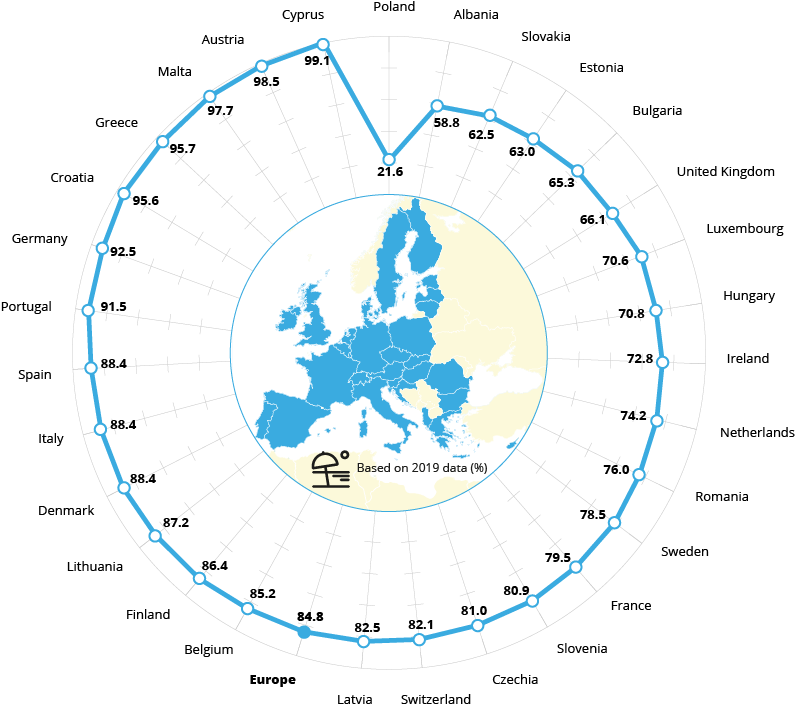The results published by the European Environment Agency (EEA) and the European Commission give a good indication where swimmers can find the best quality bathing waters. However, due to the coronavirus outbreak and restrictive measures put in place across Europe, members of the public are advised to seek updated information from local and national authorities and beach operators about safety measures at bathing sites. To help Member States gradually lift travel restrictions and allow tourism businesses to reopen, after months of lockdown, while respecting necessary health precautions the Commission presented on 13 May a package of guidelines and recommendations.
Virginijus Sinkevičius, Commissioner in charge of the Environment, Fisheries and Oceans, said, “Clean bathing water is usually taken as something that is gifted, but it’s actually one of the European collective achievements. It’s the result of hard work by many people over many years. This year’s report once again confirms that European citizens can continue to enjoy very high quality standards when bathing in European waters and all measures must be taken to continue along this path.”
Hans Bruyninckx, EEA Executive Director, said: "Regular monitoring and assessment of bathing water are essential for ensuring that we maintain the already very high quality across Europe and, where needed, we take effective measures to address water pollution. Cleaner bathing waters do not only benefit our own health and well-being but also the health of the environment.”
monitored bathing water sites across Europe
with ‘Excellent’ bathing water quality
Almost all of the 22,295 bathing water sites monitored last year across Europe (of which 21,981 were in the then 28 Member State EU including the United Kingdom) met the minimum quality requirements according to the briefing. Albania and Switzerland also monitored and reported on the quality of their bathing water sites and their data are included in the assessment.
Specific results showed only minor drops in sites meeting the highest ‘excellent’ standards, and the minimum ‘sufficient’ quality requirements set out in the EU’s Bathing Water Directive. ‘Excellent’ quality bathing water sites across Europe stood at 85 %. Those meeting the least minimum ‘sufficient’ standing stood at 95 %. The briefing also found that the quality of coastal swimming sites is better than those located inland.
The number of overall 'poor' rated sites stood at 1.3 % of all sites monitored in Europe last year. That figure has not fluctuated much since 2013, when the figure stood at 2 %, reflecting the long-term improvements in bathing water quality in Europe.
Europe's bathing water quality has vastly improved over the last 40 years, when the EU's Bathing Water Directive was introduced. Effective monitoring and management introduced under the directive, combined with other EU environmental legislation such as the Urban Waste Water Treatment Directive (1991), led to a drastic reduction in untreated or partially treated municipal and industrial waste water ending up in bathing water. As a result, more and more sites are not only meeting the minimum quality standards but have also improved their quality to the highest standards. Alongside this year's report, the EEA has also released an updated interactive map showing the performance of each bathing site. Updated country reports are also available, as well as more information on the implementation of the directive in countries.
The Commission intends to launch an evaluation of the directive in the coming weeks with the intention to analyse what has worked and not. On that basis, the Commission will decide whether additional initiatives should be taken to improve the functioning of the directive.

Source: WISE bathing water quality database (data from 2019 annual reports by EU Member States 1, Albania and Switzerland).
Note: The assessment covers 22 295 bathing waters in Europe that were reported to EEA for the 2019 season. In the EU Member States, there were in total 21 981 bathing waters (Austria: 261, Belgium: 115, Bulgaria: 95, Croatia: 988, Cyprus: 113, Czechia: 153, Denmark: 1 022, Estonia: 54, Finland: 301, France: 3 348, Germany: 2 291, Greece: 1 634, Hungary: 257, Ireland: 147, Italy: 5 535, Latvia: 57, Lithuania: 117, Luxembourg: 17, Malta: 87, The Netherlands: 724, Poland: 606, Portugal: 614, Romania: 50, Slovakia: 32, Slovenia: 47, Spain: 2 234, Sweden: 438, The United Kingdom: 644). Outside the EU, 314 bathing waters were reported (Albania: 119 and Switzerland: 195). In Poland, only 187 out of 606 bathing waters were quality assessed which explains the low proportion of excellent quality in this country. The majority of them were newly identified and did not have complete sets of samples yet.
Background
All EU Member States, plus Albania and Switzerland, monitor their bathing sites according to the provisions of the EU's Bathing Water Directive. The assessment of the bathing water quality under the Bathing Water Directive makes use of the values of two microbiological parameters: Intestinal enterococci and Escherichia coli.
The legislation specifies if the bathing water quality can be classified as 'excellent', 'good', 'sufficient' or 'poor', depending on the levels of faecal bacteria detected. Where water is classified as 'poor', EU Member States should take certain measures, such as banning bathing or advising against it, providing information to the public, and taking suitable corrective actions.
The contamination of water by faecal bacteria continues to pose a risk to human health, especially if it is found at bathing water sites. Swimming at contaminated beaches or lakes can result in illness. The major sources of pollution are sewage and water draining from farms and farmland. Such pollution increases during heavy rains and floods due to sewage overflow and polluted drainage water being washed into rivers and seas.
Document Actions
Share with others